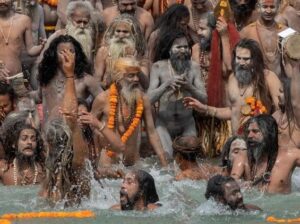Kumbh Mela 2025: A Journey Through Time and Tradition. One of the largest and most famous religious gatherings in the world. This grand Hindu pilgrimage occurs every twelve years at four rotating locations: Prayagraj, Haridwar, Ujjain, and Nashik, each situated alongside auspicious rivers. The event represents a fusion of faith, cultural richness, and historical significance, drawing millions of pilgrims and tourists who seek spiritual rejuvenation. The impending “Mahakumbh 2025” in Prayagraj marks a pivotal moment in this ancient tradition, making it crucial to unravel the rich tapestry of history and mythology behind the Kumbh Mela.
What is the History of Kumbh Mela 2025 and the Story Behind It?
Historical Origins:

The Kumbh Mela’s origins can be traced back to ancient Hindu scriptures and Puranas, wherein the festival is linked to the mythological narrative of the Samudra Manthan, or the churning of the ocean. According to Hindu mythology, this fierce cosmic endeavor involved gods and demons collaborating to extract the nectar of immortality, known as “amrita,” from the ocean. As the tale goes, during this divine act, a pot (or “kumbha”) containing the precious nectar was created. However, in the chaotic tussle for control over the nectar, droplets fell at four locations—Prayagraj, Haridwar, Ujjain, and Nashik—giving rise to the Kumbh Melas in these sacred sites.
Both historical records and archaeological evidence indicate that the tradition of mass pilgrimage at these sites began centuries ago. Notably, it gained momentum during the early medieval period, particularly under the influence of key religious figures like Adi Shankara, who promoted the gathering for philosophical discourse and spiritual introduction. However, historical evidence of organized Kumbh Melas specifically as we know them today is noted from the 19th century, during British colonial rule in India.
The Kumbh Mela at Prayagraj is recognized particularly for its grandiosity, being held at the confluence where the Ganges, Yamuna, and the mythical Sarasvati rivers meet. This convergence amplifies its spiritual significance, as many believe that bathing in these sacred waters purifies the soul and absolves sins. The event has also been celebrated in various forms over the years, with rituals that establish it as a major socio-religious festival for the Hindu community.
The Structure and Evolution of Kumbh Mela:
Kumbh Mela consists of several traditional rituals including the ritual dip, known as “snan,” at pre-specified auspicious dates determined by astrological alignments. The festival revolves around the concept of “shahi snan” (royal bathing), which is performed by saints from different akharas (sectarian groups) and represents their spiritual rank.
The term “Mahakumbh 2025” refers specifically to the larger congregational events celebrated once every 144 years, adding layers of significance. As the Mahakumbh 2025 approaches, expectations are building for enormous attendance and elaborate festivities. Historically, the Kumbh Mela has acted not just as a spiritual pilgrimage but also a significant socio-economic event, influencing local commerce and tourism.
The Socioeconomic Impact of Kumbh Mela:

Over the years, Kumbh Mela has grown into a colossal event that caters to local economies. The influx of pilgrims creates opportunities for local vendors, hoteliers, and service providers who cater to the needs of visitors during the festival. The estimated economic impact of the Mahakumbh 2025 is projected to be monumental, with discussions around revenue generation ranging from INR 2 lakh crore to INR 4 lakh crore.
Moreover, the festival serves as a melting pot of cultures and traditions, allowing pilgrims to engage in spiritual discussions, cultural performances, and community services. It amplifies the spirit of unity amid diversity, fostering communal bonds among attendees. The collaborative ethos of the Kumbha Mela illustrates how tradition can positively influence modern society while retaining its historical essence.
Key Events and Rituals:
The festival spans several weeks, with a meticulous schedule laid out for significant bathing days. Key occurrences during the festival include the royal processions of saints, traditional music, cultural performances, and educational discussions led by spiritually learned individuals. The Shahi Snan dates during Mahakumbh 2025, as noted, include vital ceremonies on January 13 (Paush Purnima), January 14 (Makar Sankranti), January 29 (Mauni Amavasya), February 3 (Basant Panchami), February 12 (Maghi Purnima), and February 26 (Maha Shivratri).
The Spiritual Essence of Kumbh Mela:
Visitors to the Kumbh Mela often describe experiences of profound spiritual awakening. Engaging in rituals like the sacred dip, attending spiritual discourses, and connecting with sadhus (holy men) represents core aspects of this event. The narratives intertwined within the Kumbh Mela resonate deeply with the collective spiritual consciousness of the Hindu community, encapsulating beliefs in purification and salvation.
The Mahakumbh 2025 will serve as a beacon of faith, tradition, and spiritual engagement. The anticipation surrounding this event emphasizes the enduring significance of the Kumbh Mela within Indian society and worldwide.
Conclusion:
The history of Kumbh Mela is deeply woven into the fabric of Hindu mythology, spirituality, and culture. As the Mahakumbh 2025 approaches, it promises to be a paramount occasion for millions who seek divine connection and transcendental experiences. The continued relevance and evolution of this powerful festival highlight its significance and role as a unique phenomenon that encapsulates the essence of Hindu belief while adapting to modern-day social and cultural dynamics.
FAQs about Kumbh Mela
Kumbh Mela is significant as a spiritual gathering that purifies the soul and absolves sins through holy bathing in sacred rivers. It represents a major cultural event combining faith, commerce, and community bonding.
The Mahakumbh 2025 will take place from January 13 to February 26, 2025, at Prayagraj, with several auspicious bathing dates.
-
How can pilgrims reach the Kumbh Mela?
Pilgrims can reach Kumbh Mela via major national rail connections, bus routes, and even flights to nearby airports. Local transport facilities are efficiently managed during the festival.
-
What are the main rituals performed during the Mela?
Main rituals include the royal snan (Shahi Snan), where saints perform ceremonial baths on auspicious dates, as well as various spiritual and cultural activities along the riverbanks.
5. What safety measures are in place during the Kumbh Mela?
The Kumbh Mela authorities implement extensive safety protocols that include surveillance, crowd management, sanitation measures, and dedicated medical assistance points throughout the festival grounds.

